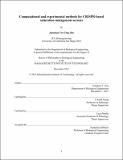| dc.contributor.advisor | Joung, J. Keith | |
| dc.contributor.advisor | Pinello, Luca | |
| dc.contributor.author | Hsu, Jonathan Yee-Ting | |
| dc.date.accessioned | 2023-10-18T17:11:25Z | |
| dc.date.available | 2023-10-18T17:11:25Z | |
| dc.date.issued | 2022-02 | |
| dc.date.submitted | 2023-09-22T15:24:55.366Z | |
| dc.identifier.uri | https://hdl.handle.net/1721.1/152504 | |
| dc.description.abstract | Genetic variation is a powerful framework for functional characterization of the human genome. The emergence of CRISPR technology has enabled the efficient and diverse installation of genetic variation in situ, leading to its widespread use in functional genomics. The application of high-throughput CRISPR saturation mutagenesis screens for the functional interrogation of the coding and non-coding genome holds great promise in accelerating our understanding of how static DNA sequences encode and influence dynamic processes in human development and disease.
In this thesis, we focus on the development of computational and experimental methods for CRISPR-based saturation mutagenesis screens. First, we developed CRISPR screening uncharacterized region function (CRISPR-SURF), a deconvolution framework for the analysis of CRISPR saturation mutagenesis screens. Drawing inspiration from the field of signal processing, we propose the modeling of CRISPR perturbations across an underlying genomic regulatory signal by means of a convolution operation and apply CRISPR-SURF for the discovery of non-coding regulatory elements involved in gene regulation. Second, we developed PrimeDesign to facilitate the rapid design of prime editing (PE) guide RNAs and demonstrate its utility by using recommended designs to install pathogenic variants in human cells. Complementing PrimeDesign, we developed pegPool as a high-throughput pooled screening strategy for prime editing guide RNA (pegRNA) optimization. We demonstrate the generalizability of pegPool by assessing a total of >18,000 pegRNA designs, with up to 210 designs in a single pool, to identify high efficiency pegRNA constructs targeting genomic sites. Finally, we developed multiplexing of site-specific alterations for in situ characterization (MOSAIC) as a rapid non-viral method for saturation mutagenesis screens at single-nucleotide and codon resolution. Using MOSAIC, we demonstrate in situ saturation mutagenesis of the BCR-ABL1 oncogene to identify drug resistant variants and IRF1 untranslated region (UTR) to map non-coding regulatory elements involved in transcriptional initiation. | |
| dc.publisher | Massachusetts Institute of Technology | |
| dc.rights | In Copyright - Educational Use Permitted | |
| dc.rights | Copyright MIT | |
| dc.rights.uri | http://rightsstatements.org/page/InC-EDU/1.0/ | |
| dc.title | Computational and experimental methods for CRISPR-based saturation mutagenesis screens | |
| dc.type | Thesis | |
| dc.description.degree | Ph.D. | |
| dc.contributor.department | Massachusetts Institute of Technology. Department of Biological Engineering | |
| mit.thesis.degree | Doctoral | |
| thesis.degree.name | Doctor of Philosophy | |
